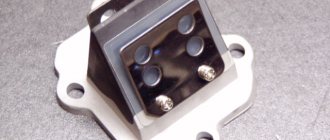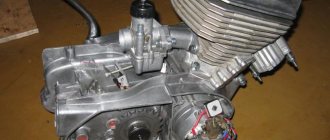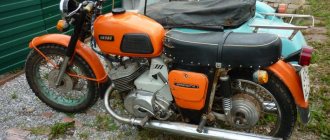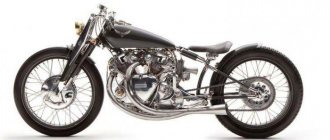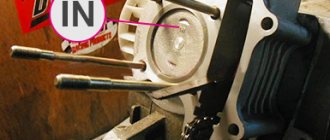The difference between two-stroke and four-stroke
The main difference between two-stroke and four-stroke engines is determined by the difference in their gas exchange devices - supplying the fuel-air mixture to the cylinder and removing exhaust gases. In a 4T engine, the processes of cleaning and filling the cylinder are carried out using a special gas distribution mechanism (GDM), which closes and opens the intake and exhaust valves at specific times in the operating cycle. In a 2T engine, filling and cleaning of the cylinder is carried out in parallel with the compression and expansion strokes - at a time when the piston is located near BDC (bottom dead center). To do this, there are two holes in the cylinder walls - inlet (purge) and outlet, through which the fuel mixture is supplied and exhaust gases are released. The two-stroke engine does not have a distribution mechanism with valves, which makes it much lighter and simpler.
Engine operation 2t | 4t engine operation |
Dynamic capabilities
Two-stroke. Due to its short operating cycle, it allows the scooter to pick up speed faster, while the response to turning the gas lever is more sensitive. Purely in terms of sensations, riding such a vehicle, especially at high speeds, is comparable to riding a sports motorcycle. Connoisseurs of high speeds, this is your choice.
Four-stroke. Scooters with such an engine, due to the longer stroke of the latter, provide “elastic” acceleration and smooth, smooth movement. The vibrations that the motor creates are almost imperceptible, even if you drive at high speed. This provides significantly greater comfort while riding and makes it easier to control the bike.
Which engine is more powerful: 2 stroke or 4 stroke?
Unlike a 4 ton engine, in which one power stroke occurs per two revolutions of the crankshaft, in a 2 ton engine, a power stroke occurs with each revolution of the crankshaft. This means that a two-stroke engine must have (in theory) twice the liter power (ratio of power to engine displacement) than a four-stroke engine. But in practice the predominance is only 1.5 - 1.8 times. This happens due to inadequate use of the piston stroke during expansion, a worse mechanism for ridding the cylinder of exhaust gases, the consumption of a share of power for purging and other phenomena associated with the distinctive features of gas exchange in 2-stroke engines.
Which is the best 50cc scooter to buy?
TOP 10 best with volume up to 50 cc.
m.
- HONDA DIO AF68. The leader of our rating is the Japanese HONDA DIO AF68.
- Honda Zoomer. In its homeland, this scooter
is popular among young people. ... - Suzuki ZZ. The top three is opened by the compact Japanese Suzuki. ...
- Suzuki Verde. ...
- Irbis LX 50
. … - SYM Symphony SR 50
. … - Sym Jet SportX 50SR. ...
- KEEWAY Street 50
. …
Grease 4 t and 2 t
Two-stroke and four-stroke engines have engine lubrication systems that differ in design and operating principle. In 2-stroke scooters, it is carried out by mixing motor oil with fuel in prescribed proportions (usually 1:25 ... 1:50). The fuel-air-oil mixture, circulating in the crank and piston chambers, lubricates the connecting rod and crankshaft bearings, as well as the cylinder bore. When the fuel mixture ignites, the oil burns together with gasoline. Its combustion products are removed along with exhaust gases.
There are 2 methods of mixing oil with gasoline. Normal mixing before pouring fuel into the tank and a separate feed, in which the fuel-oil mixture is formed in the inlet pipe located between the carburetor and the cylinder.
Separate lubrication system for two-stroke engine
- oil tank
- carburetor
- throttle cable separator
- throttle handle
- oil control cable
- plunger dosing pump
- hose supplying oil to the inlet pipe
All modern 2T scooters use a separate oil supply (we fill 2T oil separately from gasoline). In a two-stroke scooter, the engine has an oil tank, the pipeline of which is connected to an oil pump that supplies oil to the inlet pipe in the amount required depending on the amount of air-gasoline mixture. The productivity of the pump depends on the position of the throttle handle. The more fuel is supplied, the more oil is supplied, and vice versa. A separate lubrication system for two-stroke engines is considered more flawless. With it, the ratio of oil to gasoline under light loads can reach 1:200, which leads to a reduction in smoke, reduced soot formation and oil consumption. This design is used on modern scooters with two-stroke engines.
In a four-stroke engine, oil is not mixed with fuel , but is supplied separately. For this purpose, the engines are equipped with a traditional lubrication system consisting of an oil pump, filter, valves, and pipelines. The role of the oil tank can be performed by the engine crankcase (wet sump lubrication system) or a separate tank (dry sump system).
Wet and dry sump four-stroke engine lubrication system
- oil pan
- oil intake
- oil pump
- oil filter
- safety valve
When lubrication with a “wet” sump, pump 3 absorbs oil from the sump, pumps it into the outlet cavity and then delivers it through the channels to the crankshaft bearings, crankshaft and timing gear parts. When using dry sump lubrication, oil is poured into a tank, from where it is pumped to the rubbing surfaces. That part of the oil that flows into the crankcase is pumped out by an auxiliary pump, which returns it back to the tank. There is a filter to clean the oil from wear products of engine parts. If necessary, a cooling radiator is also installed, since during operation the oil temperature can rise to high temperatures.
Read also
Diagnosis of scooter malfunctions
15. Diagnosis of scooter malfunctions Even such a simple and reliable mechanism as a scooter can break. The reason for this may be poor quality and untimely maintenance, bad gasoline, general fatigue of mechanisms, banal vibration, road dirt, etc.
Scooter repair
16. Scooter repair 16.1. Scooter repair. Facings - removal and installation Partial or complete removal of the facings is necessary for most scooter maintenance and repair operations. ATTENTION! The plastic of the scooter is fragile; when removing and installing it, you must
16.11. Scooter repair. Tires - replacement
16.11. Scooter repair. Tires - replacement REMOVAL 1. Remove the cap from the valve, press the spool to relieve pressure in the tire.2. We remove the wheel (see Front wheel - removal and installation or Rear wheel - removal and installation. 3. Set the tire beads from the landing
16.15. Scooter repair. Brake fluid - replacement
16.15. Scooter repair. Brake fluid - replacement CAUTION! Brake fluid is toxic, use caution when working with it. If it comes into contact with skin, wash it off with warm water and soap. WARNING: Use only the type of brake fluid recommended
16.16. Scooter repair. Brake disc - replacement
16.16. Scooter repair. Brake disc - replacement The brake disc must be replaced if it is severely worn (the minimum permissible thickness of the working area is indicated on the base of the disc), or if it is deformed, for example, after the scooter has been dropped. REMOVAL To remove the brake disc
16.19. Scooter repair. Headlight light - adjustment
16.19. Scooter repair. Headlight light - adjustment1. The direction of the luminous flux of the headlight is changed by turning the adjusting screw. Adjustment is necessary when the road lighting in front of the scooter is disrupted, when the headlight beam blinds the driver of oncoming traffic, but
16.25. Scooter repair. Rear shock absorber - replacement
16.25. Scooter repair. Rear shock absorber - replacement REMOVAL Place the scooter on the center stand.1. Unscrew the bolt of the lower shock absorber mounting.2. Remove the bolt from the lower shock absorber mounting.3. Unscrew the nut of the upper shock absorber mounting, when
16.27. Scooter repair. Muffler - removal and installation
16.27. Scooter repair. Muffler - removal and installation REMOVAL 1. Holding the fixing nuts with a spanner or socket wrench, use a hex wrench to unscrew the three bolts securing the muffler to the pipe.2. Using a hex wrench, unscrew the three bolts securing the muffler to the frame and
16.29. Scooter repair. Adjusting valve clearances
16.29. Scooter repair. Adjusting the valve clearances The rear facings have been removed, the saddle with seat reservoir has been removed, the cylinder head cover has been removed (see Facings - removal and installation).1. Valve clearances are adjusted on a cold engine.
16.31. Scooter repair. Generator - disassembly and inspection
16.31. Scooter repair. Generator - disassembly and inspection REMOVAL To get to the generator, it may be necessary to remove the side trim (see Facings - Removal and Installation)1. Unscrew the screws securing the plastic fan casing.2. Remove the cover
16.35. Scooter repair. Starter relay - replacement
16.35. Scooter repair. Starter Relay - Replacement REMOVAL To remove the starter relay, you must first remove the rear trim of the scooter (see Trims - Removal and Installation).1. Using a hex wrench, unscrew the bolt securing the starter relay.2. Remove from the starter relay
16.36. Scooter repair. Starter - removal and installation
16.36. Scooter repair. Starter - removal and installation REMOVAL To dismantle the electric starter parts, you must first dismantle the variator cover, remove the variator belt and drive pulley (see CVT - disassembling and assembling the drive pulley).1. Unscrew the two screws on the front
16.38. Scooter repair. Variator belt - replacement
16.38. Scooter repair. CVT Belt - Replacement REMOVAL (Shown on removed power unit)1. Place the scooter on the center stand.2. Using a hex wrench, unscrew the kickstarter bolt and remove it from the axle.3. Unscrew all the cover bolts
16.43. Scooter repair. Oil seals - replacement
16.43. Scooter repair. Oil seals - replacement Lip seals, or oil seals, are used to seal moving joints of mechanisms, to prevent oil from leaking out of the mechanism and from getting water, dirt and dust into it. The difference between an oil seal and a simple gasket
16.44. Scooter repair. Bearings - troubleshooting and replacement
16.44. Scooter repair. Bearings - troubleshooting and replacement All bearings are divided into two large groups: plain bearings and rolling bearings, which, in turn, are ball, roller, needle, radial, angular contact, conical, etc.
What is called a stroke in an internal combustion engine?
Before talking about the cycles of power units, you need to understand what kind of beast this is. Stroke is the action produced by the piston. For example, when the piston inside the valve of a gasoline or diesel engine goes up, it is called one stroke, and when it returns down, this action is called the second stroke.
So, we figured out the cycles in a two-stroke engine. Therefore, two-stroke engines are more powerful. That is, in one revolution of the crankshaft, the valve piston manages to complete two strokes. However, they also have their disadvantages. We'll talk about this later.
In addition to two-stroke power units, there are single-stroke engines. The design of a single-cycle is simple to the point of disgrace. They consist of a single cylinder and were widespread in the past. It is still fashionable to find such engines on mopeds, motorcycles, and tractors:
All four-stroke engines operate on the Otto cycle. This cycle was named in honor of the German engineer who came up with the idea of describing the working process of an internal combustion engine with a cycle consisting of:
Now that we know what a stroke is and what the thermodynamic cycle is, let's take a look at how a four-stroke engine works.
Two-stroke internal combustion engine, its design features and description of the operating principle
Let's now look at the difference between the two stroke engines. Firstly, they have a simple design. They are easy to disassemble, change parts and put back together.
The operating principle of a two-stroke engine is as follows:
Each action from the Otto cycle occurs at the moment of a separate half-turn of the crankshaft. Therefore, it is believed that two-stroke engines are more powerful than four-stroke engines.
The mixture is also ignited with each revolution of the shaft. And the fuel and lubricant mixture itself must already be filled with oil. There is no place in a two-stroke engine where the mixture can mix with gasoline or diesel.
Therefore, car owners have to mix gasoline and oil themselves and pour the resulting substance into the tank.
Two or four, what's the difference?
Huge. Depending on what kind of equipment you use and for what purposes, both types of engines can be irreplaceable in certain conditions. It also depends on your level of motorcycle ownership. For a scooter that we usually use when moving from the point “home” to the point “work/study/shop”, of course, a four-stroke engine would be an ideal option. If only because you don’t need to mix gasoline and oil in a certain proportion, not to mention castor oil. Filled it up and went. Even if your 2T engine has a separate supply of oil and gasoline, the essence is the same - an oil-gasoline mixture operates in the combustion chamber. And the resource of a four-stroke engine will be longer.
But there is one “but”. The four-stroke engine has a full-fledged gas distribution system, which simply needs to be set in motion, and this is an extra consumption of power. For a 350cc engine, for example, the difference in power between a 2T and a 4T engine will be approximately 40-60%. For fifty dollars this is already more than noticeable. This is a huge number. Now imagine that your racing bike was equipped with an engine half as powerful as what you are used to. Scary? That's it. This is one of the reasons why training equipment may have a two-stroke engine. And besides this, a two-stroke engine has less kinetic inertia, that is, it spins up faster to maximum speed and drops it faster, that is, it is more flexible and elastic than a four-stroke engine.
For example, the two-stroke Suzuki RM85 (picture above) is almost 2 times faster than the four-stroke Honda CRF100 (picture below).
Now such an important thing as weight. A four-stroke engine is heavier and this is not discussed. On the one hand, it is easier to handle a motorcycle with a low center of gravity. But in order to be prepared for any surprises, not only on the race track, but also on a simple road, it is advisable to imagine that the weight of the engine has been reduced by half, and this will force you to work with your body, and not rely on the weight of the engine. Another argument in favor of the two-stroke as a training technique.
What is called a stroke in an internal combustion engine?
A stroke on an internal combustion engine is an action that takes place inside the mechanism. Moving the piston in the upper or lower direction is the stroke. Moreover, one stroke is when the piston moves upward, performing the corresponding work. The downward movement of the piston, which returns from the force generated by the combustion of fuel, is called the power stroke.
The first stroke from which the engine begins to operate is filling the cylinder with the fuel mixture. The next stage is the compression of the incoming mixture into the engine. Next, ignition occurs, and finally the removal of burnt gases. These are the four strokes that are performed in four-stroke engines. The crankshaft in four-stroke units makes two revolutions with one ignition of the fuel.
Two-stroke engines operate in two cycles - transporting the fuel mixture into the cylinder with its subsequent ignition, and removing exhaust gases from the cylinder. In two-stroke units, the crankshaft makes one revolution when burning one portion of the fuel mixture.
This is the main difference between the units under consideration and each other.
2-stroke and 4-stroke internal combustion engines are available in gasoline and diesel fuel types. To find out in detail what advantages and disadvantages are available in the 2- and 4-stroke engines under consideration, let us consider their design and operating principle.
What is an internal combustion engine on gas-powered tools?
An internal combustion engine is a unit that transforms fuel into mechanical energy. Today, internal combustion engines are used everywhere - from tools to cars and other types of equipment. The principle of operation of the internal combustion engine is due to the fact that a combustible mixture based on gasoline with air is supplied to the design. The carburetor is responsible for creating the desired consistency of the combustible mixture.
The combustible mixture is fed into the cylinder, where it is ignited. The combustion of the mixture creates useful energy that is removed from the crankshaft in the form of rotational movements. The main advantage of the internal combustion engine is that it has high power when compared with electric motors. Most gas-powered tools—trimmers, brush cutters, walk-behind tractors, chainsaws, etc.—are equipped with two-stroke internal combustion engines. More powerful petrol tools are equipped with a four-stroke internal combustion engine. What is the difference between two-stroke and four-stroke engines, what operating principle do they have, as well as their pros and cons are described in the material.
